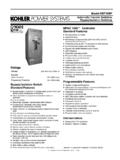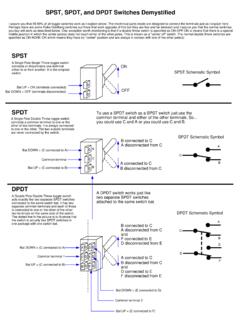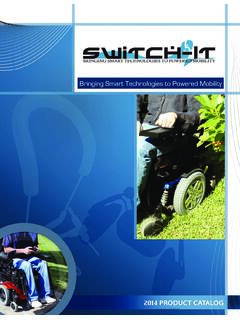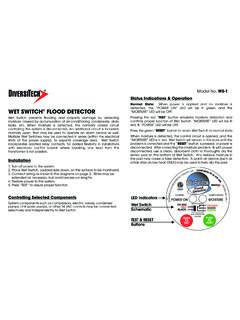Transcription of Switch: How To Change Things When Change Is Hard
1 switch : How to Change Things when Change Is Hard Listen in as co-author Chip Heath explains why some attempts to Change are more successful than others. Listen to comprehensive interview with the author at: Or Read: Six-Minute Summary of switch switch : How To Change Things when Change Is Hard If you are in the role of a Change agent this book is your manual. Up to this point, the bible for organizational Change has been John P. Kotter s book Leading Change published by the Harvard Business School. Based on his article Eight Reasons Why Transformation Efforts Fail, Kotter outlines (not surprisingly) an eight stage process for changing a culture: 1. Establish a sense of urgency. 2. Create the guiding coalition. 3. Developing a vision and strategy. 4. Communicating the Change vision. 5. Empowering employees for broad based action.
2 6. Generating short term wins. 7. Consolidating gains and producing more Change . 8. Anchoring new approaches in the culture. I have found it quite valuable in the past to challenge a leadership team to assess their own efforts against these factors, then listen to what the next level down has to say. There is always a large gap what the leaders THINK they are saying clearly is much more muddled to the listeners. Chip and Dan Heath take Things down another couple of levels. They deal with the psychology what goes on between our ears, and their process maps very well back to Kotter s as a much more explicit how to. This book summary and review of switch : How To Change Things when Change Is Hard was prepared by Jennifer Marie Duplantis while a Business of Administration student in the College of Business at Southeastern Louisiana University.
3 On this topic Executive Summary This is a remarkable book about how to Change Things when Change is hard. It can be about you, a job, friends, or even family. Change is very difficult and hard to do without a little motivation. The book helps you to look at Things in a different way than you had before. Seeing the good Things about why you should Change and why it was better before. One way Dan and Chip Heath, the authors, explained it in the book was that we have two parts to us. We have the emotional side (the Elephant) and the rational side (the Rider). Most of us think that the Rider always controls the Elephant, but in most cases it s the other way around. The Elephant somehow ends up controlling the Rider. It s like they talked about in the book, about someone trying to go on a diet. Your Rider side wants to look slimmer and eat healthier but your Elephant side loves those cookies and fast food.
4 The Rider and Elephant both need to be on the same page to be able to work together but usually this isn t the case. Your heart may want one thing but your mind may want another. That is the Rider and the Elephant at war. This book teaches you have to be on the same page with your emotional and rational side. It teaches you how to react to certain situations that are very simple and easy to do. Now they aren t saying Change is easy, by far it is one of the hardest Things in your life depending on what it is that you are fighting to Change . There are better ways to make a Change than probably what most think. Most likely they are plain and simple but you have to set forth a goal to achieve this Change . One can t say, Hey I want to lose weight soon and just automatically it starts to happen. No! One must set realistic goals as Hey I want to lose 10 pounds in the next 3 months.
5 This is your rider and elephant starting to work together. Your elephant now has motivation and your rider has direction. switch is arranged around a correlation (immediately visual and sticky). when we are making a decision we're often torn between our rational, logical reasons and our emotional, intuitive feelings. Tell the Rider what to do, provide a good argument and the Rider will do it. The Elephant, on the other hand, represents our emotions, our gut response. The Rider might like to avoid those chocolate chip cookies but there is very little the Rider can do if the Elephant really wants it. To complete their comparison they include the Path they are travelling along. If the Rider can direct the Elephant down a well prepared Path then there is a good chance for Change . The Path might represent, for example, access to user friendly technology or effective office space design.
6 switch is arranged in three parts: Direct the Rider, Motivate the Elephant and Shape the Path. The Ten Things Managers Need to Know from switch 1. Our emotions can overwhelm our rational thought, while relying solely on rational behavior can overanalyze and over think Things . 2. There are better ways to make a Change than probably what most think. Most likely they are plain and simple but you have to set forth a goal to achieve this Change . One can t say, Hey I want to lose weight soon and just automatically it start to happen. No! One must set realistic goals. 3. What looks like a people problem is often a situation book considers Change at every level- individual, organizational, and societal. All Change efforts usually have something in common: For anything to Change , someone has to start acting differently.
7 But the question is always that, Can you get people to start behaving in a new way? Dan and Chip mention in this chapter that In our lives, we embrace lots of big changes- not only babies, but marriages and new homes and new technologies and new job duties. So that means that it is quite possible for people to Change . 4. What looks like laziness is often exhaustion. The Elephant and Rider are usually on two different pages and trying to persuade the Elephant often exhaust your mind. For example, when you try so hard to stay away from fattening foods because you are on a diet, you mind will get exhausted and won t want to find the temptation any longer forcing you to finally give in. The Elephant will usually win over the Rider. 5. The Rider part of our minds has many strengths. The Rider is a thinker and a planner and can plot a course for a better future.
8 But as we ve seen, the Rider has a terrible weakness- the tendency to spin his wheels. The Rider loves to contemplate and analyze, and, making matters worse, his analysis is almost always directed at problems rather than at bright spots. 6. We are all human but sometimes we tend to make the default planbecause that was the first plan given to us and when looking at the facts we look at the negative side, which then leads us to our first decision, which may not always be the best. 7. Make sure your goals are reachable and specific. If not then you may tend to go in circles when trying to achieve your goal. Taken small steps are best way to achieve any big time Change in your life. Too big of a step can end up being too overwhelming and cause you to give up more easily. 8. In highly successful Change efforts, people find ways to help others see the problems or solutions in ways that influence emotions, not just thought.
9 In other words, when Change works, it s because leaders are speaking to the Elephant as well as to the Rider. Change only works if the Elephant and Rider are working together. 9. The gates of large goals are lined with small accomplishments. Remember to compliment yourself when completing little steps towards your goal, it will help motivate you. 10. Any new quest, even one that is ultimately successful, is going to involve can t learn to salsa-dance without failing. You can t learn to be an inventor, or a nurse, or a scientist, without failing. Nor can you learn to transform the way products are developed in your firm, or Change minds about urban poverty, or restore loving communication with your spouse, without failing. And the Elephant really, really hates to fail. So how is it that you keep the Elephant motivated to not give up?
10 The answer may sound strange: You need to create the expectation of failure- not the failure of the mission itself, but failure en route. Full Summary of switch Introduction This book teaches you how to be on the same page with your emotional and rational side. It teaches you how to react to certain situations that are very simple and easy to do. Now they aren t saying Change is easy, by far it is one of the hardest Things in your life depending on what it is that you are fighting to Change . There are better ways to make a Change than probably what most think. Most likely they are plain and simple but you have to set forth a goal to achieve this Change . Through the entire book Dan and Chip use the example of an Elephant and a Rider, the Elephant is your emotional side and the Rider is your rational side.









